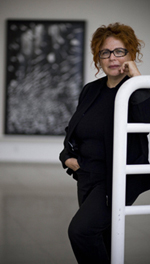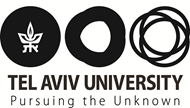The Michel Kikoine Prize
The Michel Kikoïne Prize – a gift of the artist's daughter, Mrs. Claire Maratier-Kikoïne of Paris – is given to encourage and reward Israeli artists. The prize is awarded annually since 2008 in the month of May, shortly before Michel Kikoïne's birth date (May 31, 1892).
The members of the Prize Committee are Prof. Mordechai Omer, Curator of the University Art Gallery; the art collector Doron Sebbag; the journalist and art critic Angela Levine; the artist Ofer Lellouche; and Dr. Catherine Supé- Kikoïne, who represents the Kikoïne family.
The prize ceremony is one of the events attended by Tel Aviv University's Internationsl Board of Governors, in conjunction with the French Friends of Tel Aviv University.
The prize is given to fund an exhibition at the Michel Kikoïne Foundation, and the Genia Schreiber University Art Gallery.
Michel Kikoïne (1892–1968) was born in Belarus and lived in Paris, and was one of the best-known artists affiliated with the School of Paris. Michel Kikoïne and the other members of the School of Paris occupy an important place in the history of 20th century art.
A rich collection of his works, donated by his daughter, Mrs. Claire Maratier- Kikoïne, Kikoïne is on permanent display in the Michel Kikoïne Foundation gallery. The foundation, which has also been donated by Mrs. Claire Maratier- Kikoïne, is an integral part of the University Art Gallery.

Maya Cohen Levy's new urban landscapes include both oil paintings on canvas and peeled, manipulated photographs. These two techniques are simultaneously employed by Cohen Levy in her recent works, which are composed of different thematic series (stairs, electric poles, towers, bridges and intersections).
These motifs, images and techniques are all employed by Cohen Levy to create states of indetermination, ambiguity and uncertainty. The representation of these states is structured through the repetitive fusion of geometrically ordered surfaces with a shadow that appears within or upon them. The subversion of the order that she herself had imposed is visually represented in terms of the contradiction between the perception of the pattern as a uniform, systematic and controlled visual arrangement and between the appearance of the shadow as a unique, individual form distinguished from the surface. This conflict is rooted in an unresolved dynamic between the desire to make visible and to reveal and the desire to keep concealing, covering and assimilating. In visual terms, this is a conflict between the thrust to create systems based on total visibility, and between the something taking place beneath the surface, beyond the realm of what can be seen and perceived.
Another quintessential strategy of this kind is the covering of the Azrieli Towers with a kind of geometrically patterned epidermis. To this end, Cohen Levy used her unique peeling technique. This strategy, which involves rupturing the structure's metallic setting and peeling off its rigid cover, similarly recurs in her treatment of industrial structures such as a bridge and electric poles. In all of these works, the painting functions, from an optical point of view, as an x-ray image that penetrates into the interior of the material mass. "The removal of the peel" – whether it is the surface layer of metal or concrete – is a consistent and obsessive strategy that appears at times as a vortex, an attack of vertigo or an experience of disorientation. The removal of this exterior peel is not an intrinsically violent act directed against the defining characteristics of capitalism or of modernity, but rather a refusal to endure the aggressive, oppressive and impermeable qualities of a rigid and uniform surface that does not respond to the viewer's gaze, voice or presence. This refusal bespeaks an inability to tolerate a physical world, or environment, which does not succumb to the artist's will and desire to penetrate it and leave an impression upon its surface. This impression is usually imprinted by means of alternate patterns that reorganize and transform the alienating surface into a more intimate and familiar one.
Alongside her large-scale photographs of the Azrieli Towers, Cohen Levy presents other urban corners – including city streets and intersections. Arbitrarily changing traffic lights, surveillance cameras and clocks that have lost control over their dials appear repeatedly in these works and bespeak a sense of anxiety stemming from the loss of dependable standards. Cohen Levy's large-scale oil paintings of Tel Aviv landscapes bring together different present, past and future perspectives forming an expansive panorama that further enhances the fear of dissolution: the traffic lights that ridicule passersby with their commands to stop or walk, the ghostly airplanes alluded to in the empty white spaces between the passages of painterly action, the broken lines created by black, orange and light-blue brushstrokes. Presence and absence are woven together with astounding meticulousness, as if Cohen Levy were attempting to harness the surrounding urban energies, if only momentarily, so as to discover their motivating force. Although these paintings bespeak the impossibility of attaining such a form of liberating insight, they are imbued with the beauty – and perhaps also the optimism – embedded in the very possibility of a dialogue between art and world.
In honor of Maya Cohen Levi winning the prize, her exhibition Maya Cohen Levy - Twilight: Urban Landscapes, Tel Aviv opened on the 14th of May 2009 at the Geneia Schreiber University Art Gallery and Michel Kikoïne Foundation.

